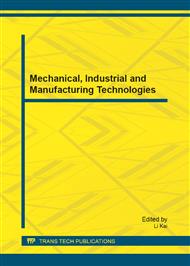p.115
p.122
p.130
p.134
p.138
p.146
p.151
p.157
p.161
Finite Element Analysis of the Static/Dynamic Behavior of Wind Turbine Gearbox
Abstract:
Gearbox is a key part and is more easily over loaded and it has a high failure rate in MW-class wind turbine. It is necessary to analyze, predict and optimize its static/dynamical behavior. It presents the performance of one type wind turbine gearbox and the static analysis results of the housing, spline and gear pairs of the wind turbine gearbox are obtained using finite element method. The natural frequency and modal shape of the gearbox are analyzed. The modification data of the flank shape for each class tooth alignment and tooth profiles are obtained from the analysis. The related data on the strength and stiffness of all the parts in wind turbine gearbox are provided. It lays a foundation for the reliability assessment and optimization design of wind turbine gearbox.
Info:
Periodical:
Pages:
138-145
Citation:
Online since:
June 2012
Authors:
Price:
Сopyright:
© 2012 Trans Tech Publications Ltd. All Rights Reserved
Share:
Citation:


